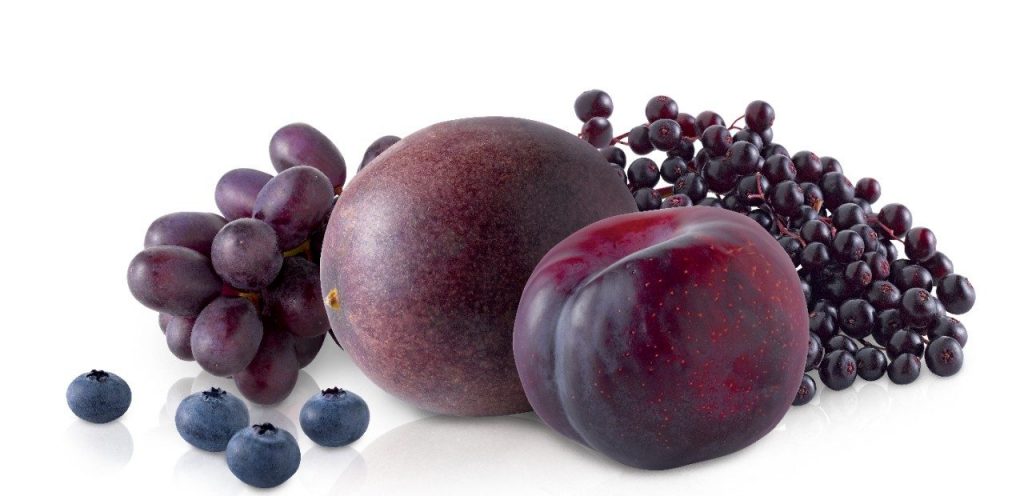
The COVID-19 pandemic has us all on edge. We’re all sheltering in place with screen time as the new normal for social support. We’re bombarded with nonstop COVID-19 news. And, we’re anxious about juggling work, school and business from home. No wonder, the world seems to be in a mental funk.
Here’s one way you can fortify your brain health so you can stay mentally sharp and resilient. And, it’s easier than you may think.
Include plenty of purple fruits and vegetables in your diet.
Why? These foods are rich in anthocyanins, the natural plant pigments that make up all shades of purple plants. And, when it comes to your brain, these foods deliver major benefits.
In the body, anthocyanins can cross the blood-brain barrier, which may be one reason they are so valuable for brain health. If you want to stay at the top of your mental game, here are five brain benefits that may inspire you to boost your intake of anthocyanin-rich purple foods:
1. Anthocyanins help protect nerve cells from oxidative stress
Oxidative stress is a common feature in Alzheimer’s disease, Parkinson’s disease and other neurodegenerative diseases. It’s a troubling state that occurs when unstable oxygen and nitrogen compounds are produced in such high amounts that they overwhelm a cell’s normal antioxidant defenses. Both forms of stress chip away at cellular structures – membranes, proteins and even DNA – resulting in severe oxidative damage and ultimately nerve cell death. Anthocyanins help protect against this damage in two key ways.
First, these plant compounds have the ability to directly scavenge both oxygen and nitrogen free radicals. It’s like throwing a wet blanket on a biochemical ember before it spirals into an inferno.
Next, anthocyanins work to enhance the cell’s intrinsic antioxidant defenses. It’s a one-two antioxidant punch that helps give nerve cells a fighting chance to thrive.

2. Anthocyanins help maintain calcium balance in nerve cells
Excitotoxicity, a phenomenon unique to neurons, occurs as a result of oxidative stress and other factors. In its wake, neurons suffer, starting with a massive influx of calcium, membrane depolarization, mitochondrial dysfunction, and ultimately cell death. Many neurotoxins work this way, including amyloid beta, one of the neurotoxic compounds thought to underlie the development of Alzheimer’s disease. Anthocyanins help control the calcium flux, according to emerging research with anthocyanin-rich plant extracts. In this way, anthocyanins ultimately help preserve calcium balance and prevent nerve cell death caused by excitotoxicity.
3. Anthocyanins help reduce neuroinflammation
Research indicates anthocyanins help reduce neuroinflammation. This is an exciting area of research that I follow closely. In the brain, microglia control the inflammatory responses. Think of these cells as the resident immune cells of the central nervous system. They can trigger short-term inflammation to remove dying cells or foreign pathogens, which is a good thing. But microglia can also trigger long-term inflammation, which is associated with neurodegeneration and death of surrounding neurons. Emerging research shows anthocyanins and anthocyanin-rich extracts exert an anti-inflammatory effect on microglial cell lines, including the ability to reduce the production of pro-inflammatory compounds.
4. Anthocyanins help stabilize proteins and remove damaged cells
Emerging research suggests that anthocyanins may provide neuroprotective benefits by directly preventing proteins from accumulating and clumping together. Scientists call this process protein aggregation, and it’s a hallmark of neurodegenerative diseases like Alzheimer’s disease and Parkinson’s disease. Anthocyanins have also been shown to directly stimulate autophagy, a process that cleans out damaged cells.
5. Anthocyanins help promote nerve cell survival
Anthocyanins are known to modulate several cell-signaling pathways involved in cell death and survival. Emerging research indicates they work in two key ways. First, anthocyanins have the ability to inhibit signaling pathways that activate cell death (apoptosis). Next, these plant compounds work to enhance the activity of pro-survival signaling pathways. Together, these dual actions help promote the survival of nerve cells.

An easy way to add purple foods to your meal plans
Purple (and red) berries are great food choices of anthocyanins, but don’t overlook other good sources like black currants and purple grapes.
If you think about it, purple plant foods are quite plentiful from carrots and cabbage to corn and potatoes to rice and tomatoes, so you don’t need to overthink this. Just look for deep purple (or bluish purple or reddish purple) colored fruits, vegetables and grains.
I hope this inspires you to bath your brain in protective anthocyanins, so you can stay mentally resilient, especially during times like these that challenge us all.
Cheers,

P.S. Don’t forget to subscribe to our RSS feed and have blog posts delivered right to your inbox.

サム博士
ありがとうございます。
栄養素の可能性を学ぶことができ、心から感謝します。